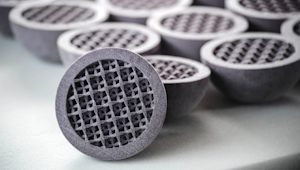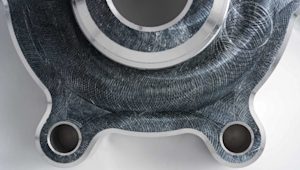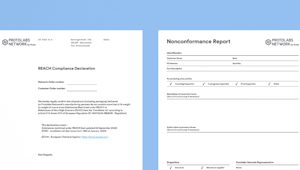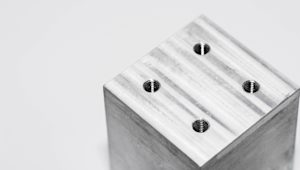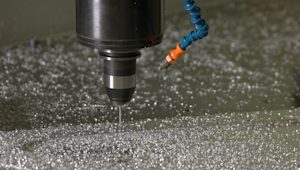Knowing the difference between tapped and rolled threads can help you make sure that your assemblies have proper fit, function, and strength. In turn, this can help you prevent mechanical failures by choosing the best fastening methods for your parts (especially those meant for industrial applications) – resulting in improved efficiency, efficacy and safety on the production floor.
Consider this your go-to resource for tapped and rolled threads for CNC machined parts, including their definitions, differences, advantages, disadvantages, and how industries are using them.
What is a tapped thread?
A tapped thread has internal threads that have been created using a tap (a tool designed to cut threads). To create a tapped thread, internal threads are cut into a pre-drilled hole. This is typically a two-step process. First, a hole is drilled into the material using a drill bit that is slightly smaller than the desired thread size. Drilling can be manual or by machine. Next, a tap is inserted into the drilled hole and rotated to the internal threads.
What is a rolled thread?
A rolled thread is created with a threading tool. The holes are not drilled before the threads are added. Instead, the threading tool creates both thread and hole at once – essentially acting as both drill and tap.
What is the difference between a tapped thread and a rolled thread?
Now that you know the definition of both tapped and rolled threads, we can clearly and briefly lay out the difference between them.
-
A tapped thread is a pre-drilled hole with threads added afterwards.
-
A rolled thread is drilled with a tool that creates threads at the same time.
Tapped threads are typically used for applications that require precise, strong connections that can handle high stress and load – as well as those in which the fastener (like a screw) must be removable.
Rolled threads are well-suited for high-volume production and applications requiring efficient, uniform, and secure connections.
In the following sections, we’ll take a closer look at the advantages and disadvantages of tapped and threaded holes, so you have a better idea of when to use each type.
What are the advantages of tapped threads?
The following are several key advantages of tapped threads.
-
Speed. Creating tapped threads is usually faster than rolled threads, which require more precision.
-
Versatility. Tapped threads can be created in various materials, including metals, plastics, and composites.
-
Reusability. Tapped threads can often be reused, which means you can more easily disassemble and reassemble parts or components
What are the disadvantages of tapped threads?
Tapped threads may present challenges to finished parts and during the manufacturing process.
-
Tool wear. Tapping tools used to create tapped threads can wear out, especially when they are used on hard materials. This means they will need to be (potentially frequently) replaced.
-
Risk of breakage. Taps can break if not used correctly or if they encounter hard spots in the material, potentially damaging both your tap and part.
-
Pre-drilled holes. Creating a tapped thread requires a pre-drilled hole, which means there’s another additional step to the manufacturing process.
What are the advantages of rolled threads?
The following are several of the key advantages of using rolled threads.
-
Strength. Rolled threads are stronger than tapped threads, because they do not impact the grain flow of a material. This makes them more suitable to critical applications.
-
Uniformity. The simultaneous creation of the hole and threads ensures high uniformity and consistency, reducing the risk of misalignment.
-
Precision. Rolled threads can create very precise and consistent threads – even more so than tapped threads – which is especially important for applications that require tight tolerances.
-
High-volume production. Rolled threads are good for parts that are produced in high volumes, as you can use a single tool for holes of all sizes.
-
Cost-effectiveness. Combining drilling and threading into a single operation can reduce labor costs and the need for multiple tools or machines.
What are the disadvantages of rolled threads?
Here are some of the challenges that rolled threads may pose.
-
Initial setup sost. Using tools – like a high-speed spindle – that can drill and thread simultaneously can involve high initial setup costs.
-
Complexity. The process can be more complex, requiring precise control and programming, which means it can take longer than tapping.
-
Maintenance. The machinery and tools used to create rolled threads can require significant maintenance to ensure continued accuracy and performance.
What are common applications of tapped and rolled threads?
As stated above, rolled threads are stronger than tapped threads. This is because tapped threads do not impact a material’s grain flow. This means that rolled threads are more suitable for critical applications. That said, we do tend to see tapped and rolled threads used more frequently for certain types of products.
-
Automotive. Tapped threads are used to secure components like cylinder heads and engine blocks. They also help hold parts of vehicle transmissions together to ensure proper alignment and more secure fastening.
-
Aerospace. Tapped threads are used in the assembly of aircraft frames and panels, as well as in landing gear assemblies.
-
Industrial machinery. Tapped threads are common in machinery for mounting motors, gearboxes, and in hydraulic manifolds and components that require secure, leak-proof connections.
-
Construction. Tapped threads are used to connect steel beams and other structural elements in buildings and homes, as they offer strong joints that can bear heavy loads. They also help attach cladding and other exterior componetns or elements to building structures.
-
Consumer electronics. Tapped threads are used to assemble electronic device housings and enclosures. Additionally, tapped holes are good for mounting PCBs.
-
Robotics and automation. Rolled threads are common in high-volume production lines for assembling products quickly and efficiently. They’re also used to mount robotic arms in automated production systems that necessitate high degrees of precision.
-
Oil and gas. Rolled threads can create secure connections in oil pipelines, drill bits, and drill stabilizers – all of which must be very precise, with tight tolerances.
-
Medical devices. High-precision surgical instruments and tools often use threaded holes for assembling parts with exact tolerances. The same goes for medical implants like bone screws and joint replacements.
-
Renewable energy sources. Rolled threads are used in the construction of wind turbines, particularly in the nacelle and rotor assembly, where strength and alignment are essential. They’re also commonly seen in mounting systems for solar panels often utilize threaded holes, as they allow for quick and easy assembly in large-scale installations.

Manufacture custom parts with tapped or rolled threads
Now that you have a solid understanding of the different types of threads, get an instant quote for your part design. If you have any questions or want to discuss a custom request, don’t hesitate to contact our experts at networksales@protolabs.com.
Frequently asked questions
What tools are used for tapped threads?
Tapping tools, such as hand taps, machine taps, and spiral point taps.
What industries use tapped threads most frequently?
Automotive, aerospace, construction, machinery, and electronics.
Can rolled threads be created manually?
No, rolled threads typically require specialized machinery for simultaneous drilling and threading.
Are tapped threads reusable?
Yes, tapped threads can be reused multiple times for disassembly and reassembly.
Which method requires more maintenance?
Rolled thread machinery often requires more maintenance due to the complexity of the combined drilling and threading tools.








